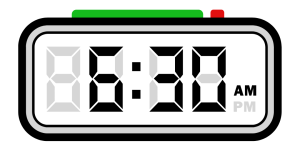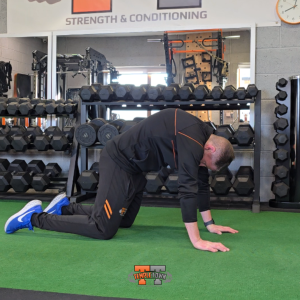Does This Sound Like Your Morning Routine?
6:30 AM alarm. You swing your legs out of bed and… ouch.

Your lower back protests like you’ve been wrestling bears all night. Your hips feel like they’re held together with superglue. You shuffle to the bathroom, shoulders hunched forward, feeling about as graceful as a rusty robot.
Sound familiar?
You’re not alone and more importantly – you’re not broken.
Every week, I work with professionals over 30 who share the same frustrating story: despite trying stretching routines, expensive foam rollers and cutting back on training, that stubborn stiffness just won’t budge. They’re convinced it’s just “getting older,” but here’s what I tell them – and what I’m about to tell you.
Age isn’t the villain. Your daily habits are.
The Real Culprits Behind Your Stiffness (Hint: It’s Not Your Birthday Count)
Let me paint you a picture of the modern stiffness epidemic. I lived it myself for years – 5 days a week of 2-3 hours commuting to and from Dublin, with 9 hours welded to an office chair in between, then straight to the gym for heavy lifting with barely a warm-up. I genuinely believed feeling like a creaky gate was just part of adult life.
I was wrong. Here’s what’s actually happening to your body:
The Sitting Time Bomb
When you’re parked in a chair for hours, your body literally moulds itself to that position. Your hip flexors shorten and tighten like overstretched rubber bands. Your glutes – your body’s powerhouse muscles – essentially go to sleep.
Meanwhile, your upper back rounds forward, creating a domino effect of compensation patterns throughout your entire body.
Meanwhile, your upper back rounds forward, creating a domino effect of compensation patterns throughout your entire body.
This isn’t just uncomfortable; it’s repositioning your entire skeletal system.
The Weak-Tight Muscle Paradox
Here’s something that surprises most people: tight muscles aren’t necessarily strong muscles. Often, they’re overworked and exhausted from doing jobs they weren’t designed for.
That chronic lower back tightness? It’s likely your back muscles desperately trying to compensate for weak, inactive glutes and a core that’s checked out for the day. Your body is essentially using duct tape solutions for structural problems.
Training Like It’s 1999 (When Your Body Isn’t)
If you’re still approaching fitness the same way you did in your twenties – minimal warm-up, ego lifting, ignoring mobility work – you’re adding stress to an already compromised system. It’s like trying to sprint in quicksand.
The Stress-Sleep-Stiffness Triangle
Chronic stress keeps your nervous system in “threat mode,” causing muscles to maintain protective tension. Poor sleep prevents proper recovery and tissue repair. Together, they create a perfect storm for persistent stiffness.
Why Your Current Stretching Strategy Is Failing You

The uncomfortable truth about stretching: doing it alone, without addressing the underlying strength imbalances and daily habits causing your stiffness, is like trying to hold water in your hands. You might feel temporary relief, but the problem returns within hours.
Tight muscles need to learn how to be both strong AND flexible through their full range of motion. They need re-education, not just passive pulling.
The Complete Stiffness Solution (What Actually Works)
This is the exact system I use with every client who comes to me feeling locked up and frustrated. It works because it addresses the root cause, not just the symptoms.
Foundation 1: Strengthen Your Body’s Support System
Target: Glutes, deep core muscles, and upper back – your body’s natural posture and movement stabilisers.
Key Exercises:
- Glute bridges and hip thrusts
- Dead bugs and bird dogs
- Farmer’s walks and loaded carries
- Rows and wall slides

Why This Works: When these muscles are strong and active, they take pressure off the overworked muscles that have been compensating. Your body finally has the support it needs to relax.
Foundation 2: Strategic Mobility (Not Random Stretching)
This isn’t about touching your toes or doing impressive yoga poses. It’s about restoring functional movement patterns your body needs for daily life.
The Daily Non-Negotiables (8-10 minutes that will change your life):
- 90-90 Hip Switches (10 per side) – Unlocks hip mobility in multiple planes
- World’s Greatest Stretch (8 per side) – Addresses hips, thoracic spine and ankles simultaneously
- Half-Kneeling Thoracic Rotations (10 per side) – Counters forward head posture
- Goblet Squat Hold (30-60 seconds) – Restores deep squat pattern
- Wall Slides (10 slow reps) – Opens chest and shoulders
The Rule: Control and precision beat intensity every time. Quality movement patterns are more valuable than impressive ranges of motion.
Foundation 3: Habit Architecture (The Unsexy Game-Changer)
Small, consistent changes in your daily routine create massive improvements in how your body feels and functions.
Movement Breaks: Set a phone reminder to stand and move for 30 seconds every hour. This simple habit prevents your body from “setting” into poor positions.
Workstation Setup: Position your screen at eye level. Keep your feet flat on the floor. Let your shoulders relax away from your ears.
Walking Medicine: Aim for 20-30 minutes of walking daily. It’s like a reset button for your entire musculoskeletal system.
Foundation 4: Smarter Training Approach
Warm-Up Revolution: Spend 10-15 minutes preparing your body for exercise. This isn’t time wasted; it’s injury prevention and performance enhancement.
Movement Quality First: Focus on how well you’re moving before how much weight you’re lifting. Perfect movement patterns create long-term strength and mobility.
Full-Body Integration: Choose exercises that require multiple muscle groups to work together, mimicking real-life movement patterns.
Foundation 5: Recovery Optimisation
Stress Management: Chronic stress keeps your muscles locked in protective tension. Incorporate 10 minutes of daily breathwork, meditation, or gentle movement.
Sleep Priority: Aim for 7+ hours of quality sleep. This is when your body repairs tissues and consolidates movement learning.

My Personal Journey From Stiff to Strong
I spent years accepting stiffness as inevitable. My daily routine was a masterclass in creating tension: long commutes, desk work, intense training with minimal preparation. I thought feeling like a rusty hinge was just the price of being a busy adult.
The transformation didn’t happen overnight, but when I committed to 10 minutes of daily targeted mobility, strengthened my neglected posterior chain and made small adjustments to my daily habits, everything changed.
Training became enjoyable again. Daily tasks stopped feeling like battles. I moved with confidence instead of caution.The best part? The solution was simpler than I thought, but it required consistency and the right approach.
The Bottom Line: Your Body Is Designed to Move Well
Chronic stiffness isn’t a life sentence, and it’s definitely not just about getting older. It’s feedback from your body about movement patterns, daily habits, and the balance between mobility and stability.
The solution isn’t more aggressive stretching or giving up activities you enjoy. It’s about creating a sustainable system that addresses the root causes while fitting into your real life.
Your body is remarkably adaptable. With the right approach, consistent application and patience with the process, you can feel strong, mobile, and confident in your movement again – regardless of your age or how long you’ve been dealing with stiffness.
The question isn’t whether you can improve. It’s whether you’re ready to invest 10 minutes a day in feeling like yourself again.
Ready to Move Better and Feel Stronger?
If you’re tired of waking up stiff and want a clear, science-backed plan to improve your movement and strength without sacrificing your busy lifestyle, let’s talk. I create personalised coaching programs that fit your life, not the other way around.
Message me today to discuss how we can get your body moving the way it’s meant to.
![]()

